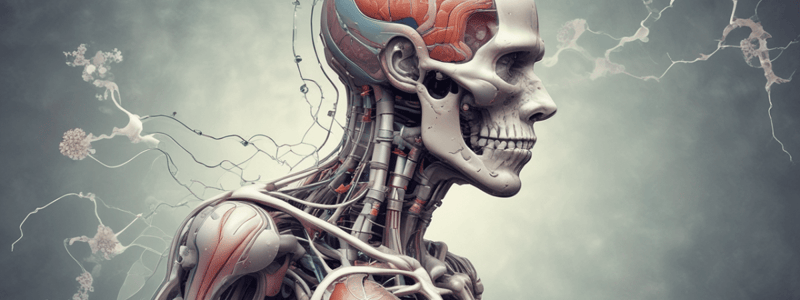Podcast
Questions and Answers
Which hormone is responsible for raising Ca2+ levels in the blood?
Which hormone is responsible for raising Ca2+ levels in the blood?
- Vitamin D
- Parathyroid Hormone (correct)
- Albumin
- Calcitonin
What percentage of total calcium in the body is found in soft-tissue cells and extracellular fluid?
What percentage of total calcium in the body is found in soft-tissue cells and extracellular fluid?
- 1% (correct)
- 20%
- 10%
- 5%
What is the total Ca2+ concentration in blood?
What is the total Ca2+ concentration in blood?
- 5 mg/dL
- 10 mg/dL (correct)
- 20 mg/dL
- 15 mg/dL
What is the function of albumin in calcium regulation?
What is the function of albumin in calcium regulation?
Which of the following is biologically active?
Which of the following is biologically active?
What is the primary function of osteoclasts in calcium regulation?
What is the primary function of osteoclasts in calcium regulation?
What is a major consequence of hypocalcemia?
What is a major consequence of hypocalcemia?
Which of the following processes does not involve Ca2+?
Which of the following processes does not involve Ca2+?
What is the effect of hypercalcemia on membrane excitability?
What is the effect of hypercalcemia on membrane excitability?
What is the primary function of the organs that play a central role in regulating the movement of calcium between stores?
What is the primary function of the organs that play a central role in regulating the movement of calcium between stores?
What is the consequence of inadequate calcium in the body?
What is the consequence of inadequate calcium in the body?
Which of the following is a consequence of calcium's role in enzyme regulation?
Which of the following is a consequence of calcium's role in enzyme regulation?
What is the effect of acidemia on the free ionized Ca2+ concentration?
What is the effect of acidemia on the free ionized Ca2+ concentration?
What is the role of Parathyroid Hormone in bone remodeling?
What is the role of Parathyroid Hormone in bone remodeling?
What is the effect of alkalemia on the free ionized Ca2+ concentration?
What is the effect of alkalemia on the free ionized Ca2+ concentration?
What is the role of Vitamin D in Ca2+ balance?
What is the role of Vitamin D in Ca2+ balance?
What is the role of phosphate in the body?
What is the role of phosphate in the body?
What is the result of net excretion of Ca2+ by the kidney?
What is the result of net excretion of Ca2+ by the kidney?
Where are the receptors for Parathyroid Hormone located in bone?
Where are the receptors for Parathyroid Hormone located in bone?
What is the initial effect of PTH on bone formation?
What is the initial effect of PTH on bone formation?
What is the role of osteoblasts in PTH-induced bone resorption?
What is the role of osteoblasts in PTH-induced bone resorption?
What is the result of osteoclast resorption of bone?
What is the result of osteoclast resorption of bone?
What is the effect of PTH on Ca++ reabsorption in the kidney?
What is the effect of PTH on Ca++ reabsorption in the kidney?
What is the role of vitamin D in the intestine with regards to PTH?
What is the role of vitamin D in the intestine with regards to PTH?
What is the primary effect of parathyroid hormone on the kidney?
What is the primary effect of parathyroid hormone on the kidney?
Which of the following activities can lead to bone loss?
Which of the following activities can lead to bone loss?
What is the primary mechanism by which calcitonin decreases plasma Ca2+ concentration?
What is the primary mechanism by which calcitonin decreases plasma Ca2+ concentration?
What is the primary stimulus for calcitonin secretion?
What is the primary stimulus for calcitonin secretion?
What is the effect of parathyroid hormone on bone resorption?
What is the effect of parathyroid hormone on bone resorption?
Which of the following hormones has an effect on bone resorption that opposes that of parathyroid hormone?
Which of the following hormones has an effect on bone resorption that opposes that of parathyroid hormone?
Which of the following activities is most likely to promote bone loss?
Which of the following activities is most likely to promote bone loss?
What is the primary effect of Parathyroid Hormone on the kidney?
What is the primary effect of Parathyroid Hormone on the kidney?
Which of the following hormones has an effect on bone resorption that opposes that of calcitonin?
Which of the following hormones has an effect on bone resorption that opposes that of calcitonin?
What is the primary action of calcitonin in the bone?
What is the primary action of calcitonin in the bone?
What is the primary stimulus for Parathyroid Hormone secretion?
What is the primary stimulus for Parathyroid Hormone secretion?
What is the effect of Parathyroid Hormone on calcium reabsorption in the kidney?
What is the effect of Parathyroid Hormone on calcium reabsorption in the kidney?
What is the primary function of osteoclast cells in the bone?
What is the primary function of osteoclast cells in the bone?
What is the effect of calcitonin on plasma Ca2+ concentration?
What is the effect of calcitonin on plasma Ca2+ concentration?
What is the primary action of Parathyroid Hormone on the small intestine?
What is the primary action of Parathyroid Hormone on the small intestine?
What is the primary mechanism by which Parathyroid Hormone promotes bone resorption?
What is the primary mechanism by which Parathyroid Hormone promotes bone resorption?
Flashcards are hidden until you start studying
Study Notes
Calcium Metabolism
- Calcium is crucial for various physiological processes, including muscular contraction, membrane permeability, endocrine and exocrine secretions, enzyme regulation, and coagulation.
- Calcium stabilizes membrane potentials, and its imbalance can lead to manifestations such as muscle spasms, cardiac arrhythmias, and seizures.
Regulation of Calcium Metabolism
- Three tissues play a central role in calcium regulation: bone (and teeth), intestine, and kidney.
- Three hormones are involved in calcium regulation: parathyroid hormone (PTH), calcitonin, and activated vitamin D3.
- Three cell types are involved in calcium regulation: osteoblasts, osteocytes, and osteoclasts.
Parathyroid Hormone (PTH)
- PTH is produced by the parathyroid gland and raises calcium levels in the blood.
- PTH regulates blood calcium levels by promoting bone resorption, increasing calcium reabsorption in the kidney, and stimulating vitamin D activation in the intestine.
Calcitonin
- Calcitonin is produced by the thyroid gland and lowers calcium levels in the blood.
- Calcitonin is secreted in response to elevated calcium levels and opposes the effects of PTH in the bone and renal tubule.
- Calcitonin's main action is to inhibit osteoclastic bone resorption, decreasing plasma calcium concentration.
Calcium Stores in the Body
- The adult human body contains approximately 1-1.3 kg of calcium, with 99% stored in bones and teeth.
- The remaining 1% is distributed between soft-tissue cells and extracellular fluid.
Forms of Calcium in Blood
- Total calcium concentration in blood is 10 mg/dL.
- 40% of calcium is bound to plasma proteins, mainly albumin.
- Free, ionized calcium is the only biologically active form of calcium.
Acid-Base Abnormalities and Calcium
- Acid-base abnormalities alter ionized calcium concentration by changing the fraction of calcium bound to plasma albumin.
- In acidemia, free ionized calcium concentration increases.
- In alkalemia, free ionized calcium concentration decreases.
Roles of Calcium in the Body
- Calcium plays a role in signal transduction, neurotransmitter release, and muscle contraction.
- Calcium is a structural component in bone matrix and is involved in bone formation.
Calcium Balance
- Renal and gastrointestinal systems maintain a balance of calcium, with net excretion of calcium by the kidney equal to net absorption from the gastrointestinal tract.
- Bone remodeling involves the simultaneous formation of new bone and resorption of old bone.
Role of Phosphate in the Body
- Phosphate is involved in the formation of ATP, serves as a biologic buffer, and can modify protein functions.
- Phosphate can act as a biologic buffer and modulate protein functions.
Regulation of Calcium Metabolism
- The body maintains homeostasis of calcium and phosphate concentrations through various mechanisms.
- Calcium and phosphate are essential for various physiological processes, including muscular contraction, membrane permeability, endocrine and exocrine secretions, enzyme regulation, and coagulation.
Physiological Processes Involving Ca2+
- Muscular contraction
- Membrane permeability
- Endocrine and exocrine secretions
- Enzyme regulation
- Coagulation
Calcium Stabilizes Membrane Potentials
- Hypocalcemia (low calcium levels) can lead to muscle spasms, cardiac arrhythmias, and seizures due to enhanced membrane excitability.
- Hypercalcemia (high calcium levels) reduces membrane excitability, leading to muscle weakness and stupor.
Acid-Base Abnormalities and [Ca2+]
- Acid-base abnormalities alter the ionized Ca2+ concentration by changing the fraction of Ca2+ bound to plasma albumin.
- In acidemia, the free ionized Ca2+ concentration increases due to the excess of H+ ions binding to albumin.
- In alkalemia, the free ionized Ca2+ concentration decreases due to the deficit of H+ ions binding to albumin.
Roles of Calcium in the Body
- Signal transduction (neurotransmitter release)
- Second messenger
- Structural component in bone matrix
- Muscle contraction
- Bone formation
Calcium Balance
- Renal and GI: Net excretion of Ca2+ by the kidney equals net absorption of Ca2+ from the gastrointestinal tract.
- Bone remodeling: new bone is formed, and old bone is resorbed. Bone resorption is stimulated by parathyroid hormone.
Role of Phosphate in the Body
- Formation of adenosine triphosphate (ATP)
- Phosphate can serve as a biologic buffer
- Phosphate can act as a modifier of proteins, altering their functions.
Calcium and Phosphate Reabsorption
- PTH inhibits phosphate reabsorption in the proximal convoluted tubule of the nephron (phosphaturic action of PTH).
- Phosphaturia: the phosphaturic action of PTH causes the phosphate resorbed from bone to be excreted in the urine, allowing the plasma ionized Ca2+ concentration to increase.
Actions of Parathyroid Hormone (PTH)
- Inhibits phosphate reabsorption
- Stimulates Ca2+ reabsorption
- Stimulates Vitamin D synthesis
PTH and Small Intestine
- PTH indirectly stimulates intestinal Ca2+ absorption via activation of vitamin D.
Vitamin D Synthesis
- Renal cells produce 1,25-dihydroxycholecalciferol (active metabolite) or 24,25-dihydroxycholecalciferol (inactive metabolite) depending on the status of Ca2+ in the body.
- 1α-Hydroxylase activity is regulated by changing the activity of the 1α-hydroxylase enzyme.
Actions of Vitamin D
- Increases plasma levels of both Ca2+ and phosphate
- Promotes mineralization of new bone
- Has coordinated actions on the:
- Intestine: increases both Ca2+ and phosphate absorption
- Kidney: stimulates both Ca2+ and phosphate reabsorption
- Bone: stimulates osteoclast activity and bone resorption
Pathophysiology of Vitamin D
- Rickets: vitamin D deficiency causes rickets in children, leading to softening of bones
- Osteomalacia: new bone fails to mineralize in adults, resulting in bending and softening of weight-bearing bones
Bone Mass in Balance
- Osteoblasts deposit new bone
- Weight-bearing activities
- Calcium/Vitamin D
- Estrogen/Testosterone
Resorption/Bone Loss
- Osteoclast cells digest bone
- Inactivity
- Deficient nutrition
- Low Estrogen/Low Testosterone
Studying That Suits You
Use AI to generate personalized quizzes and flashcards to suit your learning preferences.



